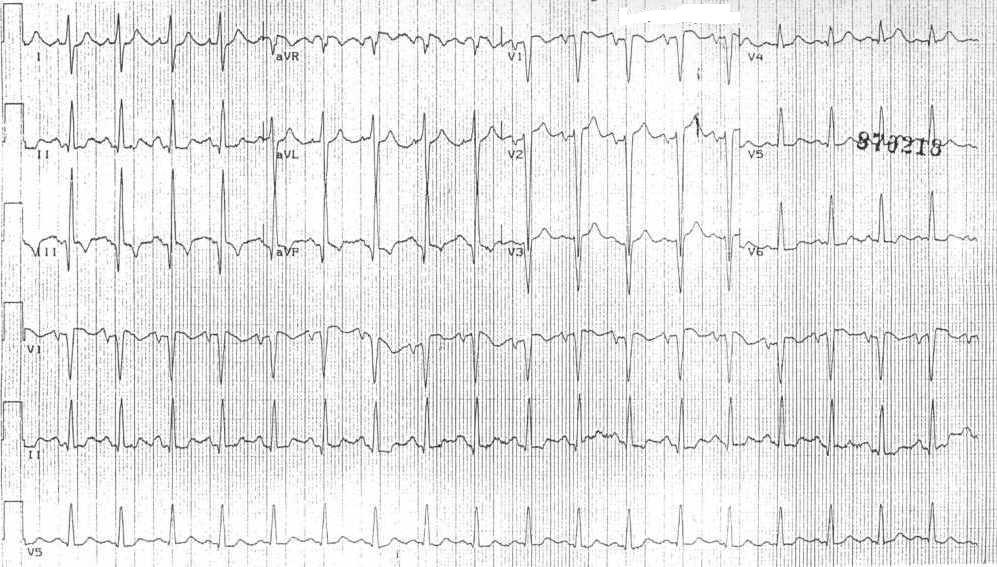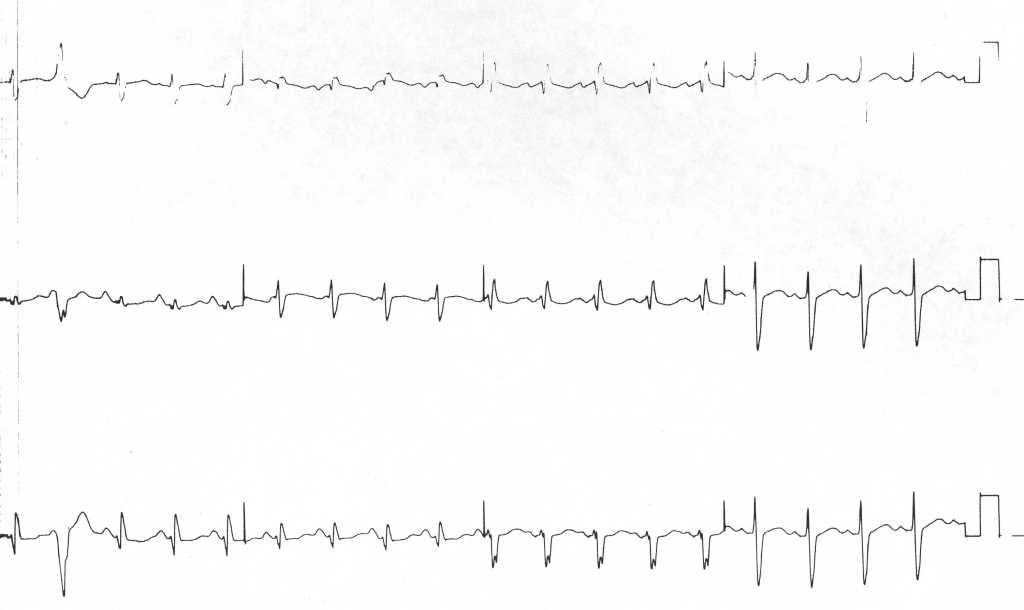Torsade de pointes
| Torsade de pointes | |
| DiseasesDB | 29252 |
|---|---|
| eMedicine | med/2286 emerg/596 |
| MeSH | D016171 |
| Cardiology Network |
 Discuss Torsade de pointes further in the WikiDoc Cardiology Network |
| Adult Congenital |
|---|
| Biomarkers |
| Cardiac Rehabilitation |
| Congestive Heart Failure |
| CT Angiography |
| Echocardiography |
| Electrophysiology |
| Cardiology General |
| Genetics |
| Health Economics |
| Hypertension |
| Interventional Cardiology |
| MRI |
| Nuclear Cardiology |
| Peripheral Arterial Disease |
| Prevention |
| Public Policy |
| Pulmonary Embolism |
| Stable Angina |
| Valvular Heart Disease |
| Vascular Medicine |
Editor-In-Chief: C. Michael Gibson, M.S., M.D. [1]
Associate Editor-In-Chief: Cafer Zorkun, M.D., Ph.D. [2]
Please Join in Editing This Page and Apply to be an Editor-In-Chief for this topic: There can be one or more than one Editor-In-Chief. You may also apply to be an Associate Editor-In-Chief of one of the subtopics below. Please mail us [3] to indicate your interest in serving either as an Editor-In-Chief of the entire topic or as an Associate Editor-In-Chief for a subtopic. Please be sure to attach your CV and or biographical sketch.
Overview
Torsade de pointes or torsades is a French term that literally means "twisting of the points" is a ventricular tachycardia associated with a long QT time on the resting ECG.
Torsade de pointes is typically initiated by a short-long-short interval. A ventricle extrasystole (first beat: short) is followed by a compensatory pause. The following beat (second beat: long) has a longer QT interval. If the next beat follows shortly thereafter, ther is a good chance that this third beat falls within the QT interval, resulting in the R on T phenomenon and subsequent Torsade de pointes. During Torsade de pointes the ventricles depolarize in a circular fashion resulting in QRS complexes with a continuously turning heart axis around the baseline (hence the name Torsade de Pointes). Read the chapter on the Long QT Syndrome for an list of causes.
Also, a more rare form of short coupled Torsade de pointes has been observed.[1]
History
It was first described by Dessertenne in 1966[2] and refers to a specific variety of ventricular tachycardia that exhibits distinct characteristics on the electrocardiogram (ECG).
Terminology
The French term is largely due to the fact that the phenomenon was originally described in a French medical journal by Dessertenne in 1966, when he observed this rhythm disorder in an 80-year-old female patient with complete intermittent atrioventricular block.
There has been much debate in the Circulation journal among French and American scientist whether one should write Torsades de Pointes or Torsade de Pointes.
As for now Torsade is prefered (unless one sees rotations around more than one axis in one episode), but both forms are used in similar frequency.[3]
Presentation

Torsades is a rapid, polymorphic ventricular tachycardia with a characteristic twist of the QRS complex around the isoelectric baseline. It is also associated with a fall in arterial blood pressure, which gives rise to the syncopal symptoms experienced by patients.
Although torsade de pointes is a rare ventricular arrhythmia, it can degenerate into ventricular fibrillation, which will lead to sudden death in the absence of medical intervention. Torsade de pointes is associated with Long QT syndrome, a condition whereby prolonged QT intervals are visible on the ECG.
Causes
Long QT syndrome can either be inherited as congenital mutations of ion channels carrying the cardiac impulse/action potential or acquired as a result of drugs that block these cardiac ion currents.
Common causes for torsades de pointes include hypomagnesemia and hypokalemia. It is commonly seen in malnourished individuals and chronic alcoholics. Drug interactions such as erythromycin or Avelox, taken concomitantly with inhibitors like nitroimidazole, Diarrhea, dietary supplements, and various medications like methadone, Lithium, tricyclic antidepressants or phenothiazines may also contribute.
Factors that are associated with an increased tendency toward torsades de pointes include:
- Familial long QT syndrome
- Class IA antiarrhythmics
- Hypomagnesemia
- Hypokalemia
- Hypoxia
- Acidosis
- Heart failure
- Left ventricular hypertrophy
- Slow heart rate
- Female gender
The List of Drugs that Causing Torsades de pointes
Drugs that are generally accepted to have a risk of causing torsades de pointes
- Amiodarone
- Arsenic trioxide
- Astemizole
- Bepridil
- Chloroquine
- Chlorpromazine
- Cisapride
- Clarithromycin
- Disopyramide
- Dofetilide
- Domperidone
- Droperidol
- Erythromycin
- Halofantrine
- Haloperidol
- Ibutilide
- Levomethadyl
- Mesoridazine
- Methadone
- Pentamidine
- Pimozide
- Probucol
- Procainamide
- Quinidine
- Sotalol
- Sparfloxacin
- Terfenadine
- Thioridazine
The List of Drugs that Possible Causing Torsades de pointes
Drugs that in some reports have been associated with torsades de pointes and/or QT prolongation but at this time lack substantial evidence for causing torsades de pointes.
- Alfuzosin
- Amantadine
- Atazanavir
- Azithromycin
- Chloral hydrate
- Clozapine
- Dolasetron
- Felbamate
- Flecainide
- Foscarnet
- Fosphenytoin
- Gatifloxacin
- Gemifloxacin
- Granisetron
- Indapamide
- Isradipine
- Levofloxacin
- Lithium
- Moexipril / HCTZ
- Moxifloxacin
- Nicardipine
- Octreotide
- Ofloxacin
- Ondansetron
- Oxytocin
- Paliperidone
- Perflutren
- Quetiapine
- Ranolazine
- Risperidone
- Roxithromycin
- Sunitinib
- Tacrolimus
- Tamoxifen
- Telithromycin
- Tizanidine
- Vardenafil
- Venlafaxine
- Voriconazole
- Ziprasidone
The List of Drugs that Causing Torsades de pointes in Certain Conditions
Drugs that, in some reports, have been weakly associated with torsades de pointes and/or QT prolongation but that are unlikely to be a risk for torsades de pointes when used in usual recommended dosages and in patients without other risk factors (e.g., concomitant QT prolonging drugs, bradycardia, electrolyte disturbances, congenital long QT syndrome, concomitant drugs that inhibit metabolism)
- Amitriptyline
- Amoxapine
- Ciprofloxacin
- Citalopram
- Clomipramine
- Desipramine
- Doxepin
- Fluconazole
- Fluoxetine
- Galantamine
- Imipramine
- Itraconazole
- Ketoconazole
- Mexiletine
- Nortriptyline
- Paroxetine
- Protriptyline
- Sertraline
- Solifenacin
- Trimethoprim-Sulfamethoxazole
- Trimipramine
Treatment
Treatment is directed at withdrawal of the offending agent, infusion of magnesium sulfate, antiarrhythmic drugs, and electrical therapy as needed.
Because of the polymorphic nature of torsade de pointes, synchronized cardioversion may not be possible, and the patient may require an unsynchronized shock (or defibrillation).
infusion of Magnesium sulphate is the drug of choice in stable patient. Temporary overdrive pacing is indicated in patients who are refractory to intravenous magnesium administration.
If the patient unstable, immediate defibrillation is indicated.
Additional Information
External Links
Torsade de Pointes related drug list
Examples: EKG's shown below are courtesy of C. Michael Gibson MS MD, and copylefted
-
12 lead EKG at admission
-
-
Examples from different resources
-
Arrhythmias in a patient with short coupled torsade de pointes[4]
-
Arrhythmias in a patient with short coupled torsades de pointes degenerating in ventricular fibrillation[5]
-
A 12 lead ECG recording example of TdP[8]
References
- ↑ Leenhardt A, Glaser E, Burguera M, Nuernberg M, Maison-Blanche P, and Coumel P. Short-coupled variant of torsade de pointes. A new electrocardiographic entity in the spectrum of idiopathic ventricular tachyarrhythmias. Circulation 1994 Jan; 89(1) 206-15. PMID 8281648
- ↑ Dessertenne F (1966). "[Ventricular tachycardia with 2 variable opposing foci]". Archives des maladies du coeur et des vaisseaux (in French). 59 (2): 263–72. PMID 4956181.
- ↑ Moise NS. As Americans, we should get this right. Circulation 1999 Sep 28; 100(13) 1462. PMID 10500317
- ↑ Leenhardt A, Glaser E, Burguera M, Nuernberg M, Maison-Blanche P, and Coumel P. Short-coupled variant of torsade de pointes. A new electrocardiographic entity in the spectrum of idiopathic ventricular tachyarrhythmias. Circulation 1994 Jan; 89(1) 206-15. PMID 8281648
- ↑ Leenhardt A, Glaser E, Burguera M, Nuernberg M, Maison-Blanche P, and Coumel P. Short-coupled variant of torsade de pointes. A new electrocardiographic entity in the spectrum of idiopathic ventricular tachyarrhythmias. Circulation 1994 Jan; 89(1) 206-15. PMID 8281648
- ↑ Leenhardt A, Glaser E, Burguera M, Nuernberg M, Maison-Blanche P, and Coumel P. Short-coupled variant of torsade de pointes. A new electrocardiographic entity in the spectrum of idiopathic ventricular tachyarrhythmias. Circulation 1994 Jan; 89(1) 206-15. PMID 8281648
- ↑ Leenhardt A, Glaser E, Burguera M, Nuernberg M, Maison-Blanche P, and Coumel P. Short-coupled variant of torsade de pointes. A new electrocardiographic entity in the spectrum of idiopathic ventricular tachyarrhythmias. Circulation 1994 Jan; 89(1) 206-15. PMID 8281648
- ↑ Khan IA. Twelve-lead electrocardiogram of torsade de pointes Tex Heart Inst J. 2001; 28 (1): 69. PMID 11330748




![Arrhythmias in a patient with short coupled torsade de pointes[4]](/images/f/f1/Shortcoupled_tdp1.jpg)
![Arrhythmias in a patient with short coupled torsades de pointes degenerating in ventricular fibrillation[5]](/images/2/2c/Shortcoupled_tdp2.jpg)
![Arrhythmias in a patient with short coupled torsade de pointes: frequent short coupled extrasystoles[6]](/images/4/42/Shortcoupled_tdp3.jpg)
![Arrhythmias in a patient with short coupled torsade de pointes: frequent short coupled extrasystoles [7]](/images/c/c9/Shortcoupled_tdp4.jpg)
![A 12 lead ECG recording example of TdP[8]](/images/f/fc/12leadTorsade.jpg)